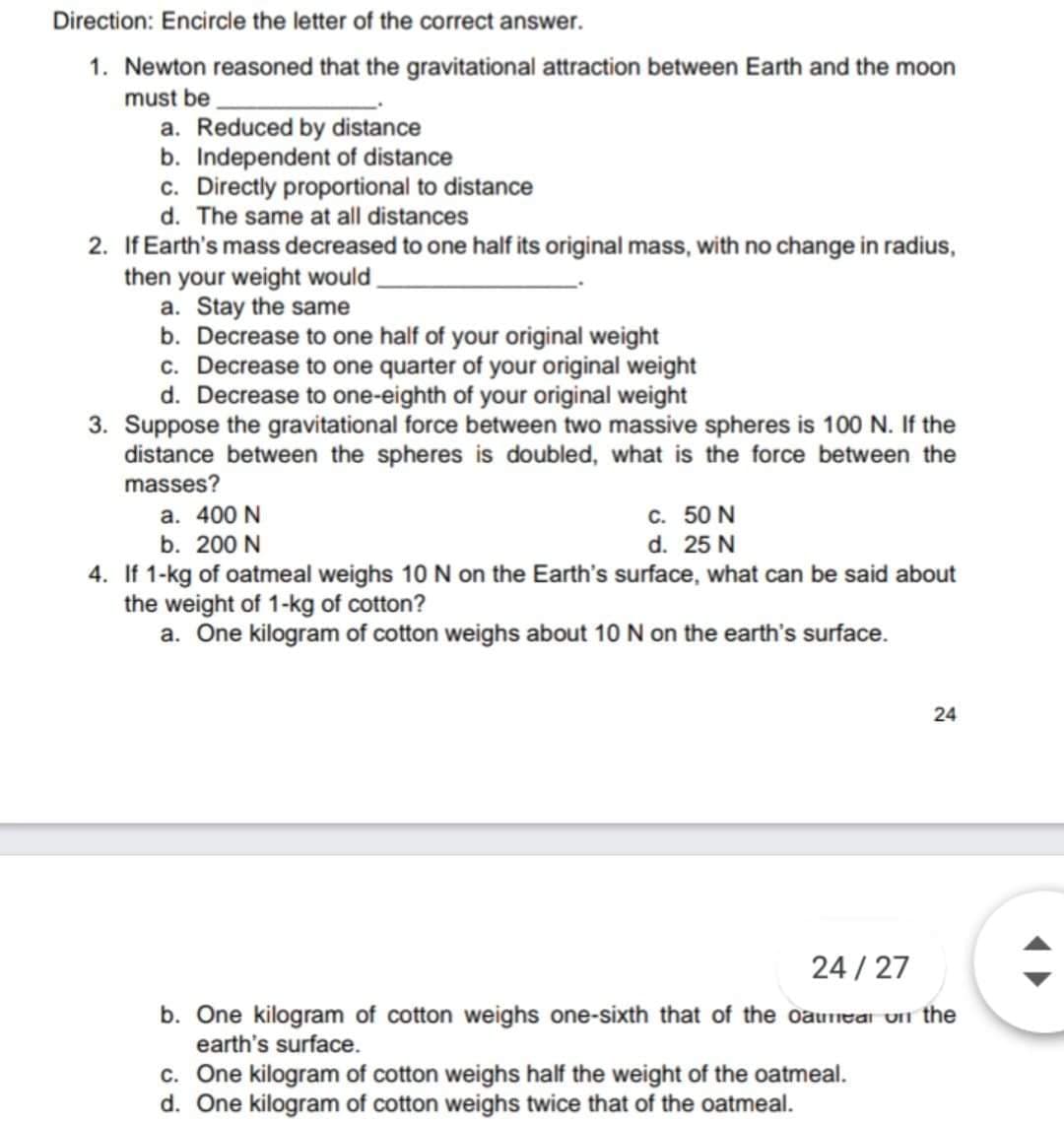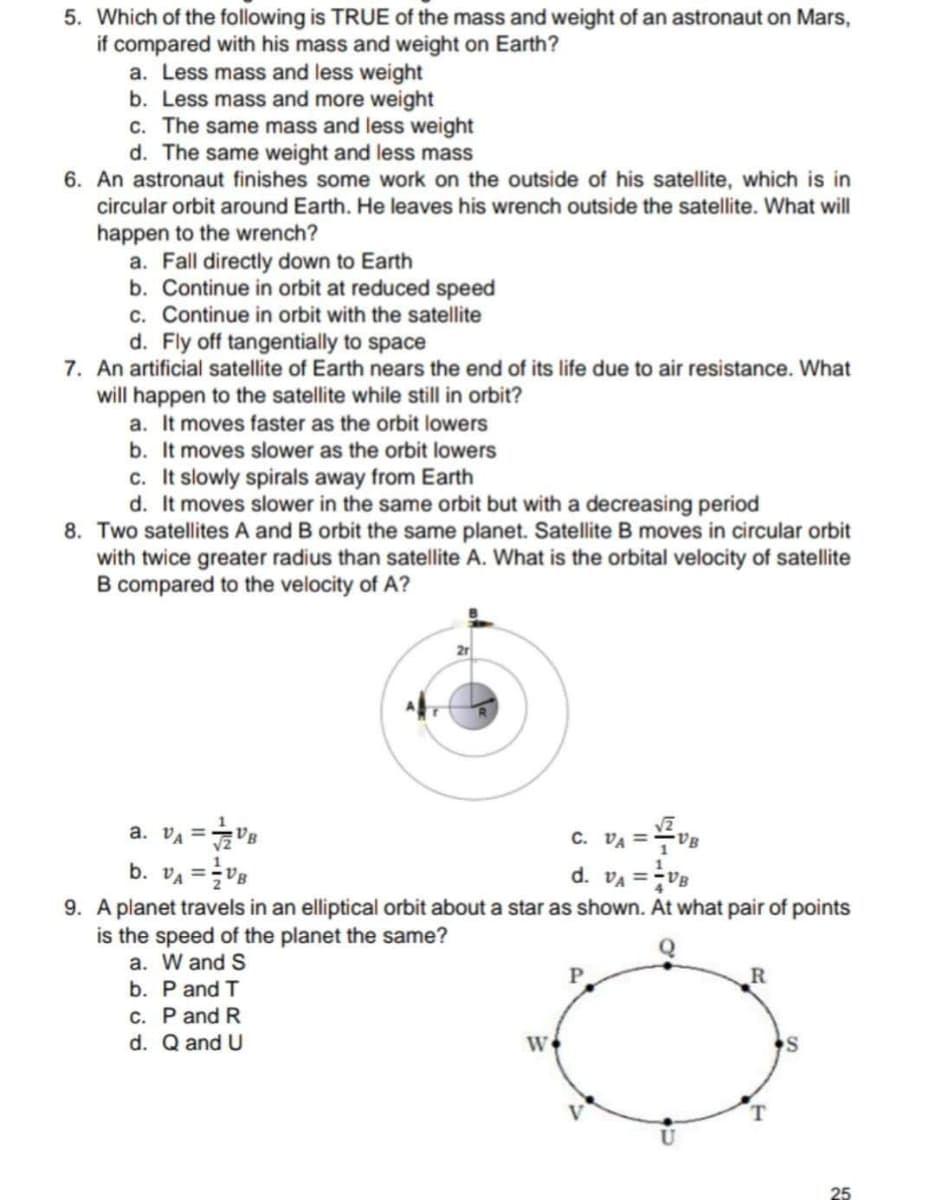1. Newton reasoned that the gravitational attraction between Earth and the moon must be a. Reduced by distance b. Independent of distance c. Directly proportional to distance d. The same at all distances
1. Newton reasoned that the gravitational attraction between Earth and the moon must be a. Reduced by distance b. Independent of distance c. Directly proportional to distance d. The same at all distances
College Physics
11th Edition
ISBN:9781305952300
Author:Raymond A. Serway, Chris Vuille
Publisher:Raymond A. Serway, Chris Vuille
Chapter4: Newton's Laws Of Motion
Section4.2: The Laws Of Motion
Problem 4.3QQ: Respond to each statement, true or false: (a) No force of gravity acts on an astronaut in an...
Related questions
Question
Answer 1-9 , no need for solutions

Transcribed Image Text:Direction: Encircle the letter of the correct answer.
1. Newton reasoned that the gravitational attraction between Earth and the moon
must be
a. Reduced by distance
b. Independent of distance
c. Directly proportional to distance
d. The same at all distances
2. If Earth's mass decreased to one half its original mass, with no change in radius,
then your weight would
a. Stay the same
b. Decrease to one half of your original weight
c. Decrease to one quarter of your original weight
d. Decrease to one-eighth of your original weight
3. Suppose the gravitational force between two massive spheres is 100 N. If the
distance between the spheres is doubled, what is the force between the
masses?
a. 400 N
b. 200 N
c. 50 N
d. 25 N
4. If 1-kg of oatmeal weighs 10 N on the Earth's surface, what can be said about
the weight of 1-kg of cotton?
a. One kilogram of cotton weighs about 10 N on the earth's surface.
24
24 / 27
b. One kilogram of cotton weighs one-sixth that of the oaurneai un the
earth's surface.
c. One kilogram of cotton weighs half the weight of the oatmeal.
d. One kilogram of cotton weighs twice that of the oatmeal.

Transcribed Image Text:5. Which of the following is TRUE of the mass and weight of an astronaut on Mars,
if compared with his mass and weight on Earth?
a. Less mass and less weight
b. Less mass and more weight
c. The same mass and less weight
d. The same weight and less mass
6. An astronaut finishes some work on the outside of his satellite, which is in
circular orbit around Earth. He leaves his wrench outside the satellite. What will
happen to the wrench?
a. Fall directly down to Earth
b. Continue in orbit at reduced speed
c. Continue in orbit with the satellite
d. Fly off tangentially to space
7. An artificial satellite of Earth nears the end of its life due to air resistance. What
will happen to the satellite while still in orbit?
a. It moves faster as the orbit lowers
b. It moves slower as the orbit lowers
c. It slowly spirals away from Earth
d. It moves slower in the same orbit but with a decreasing period
8. Two satellites A and B orbit the same planet. Satellite B moves in circular orbit
with twice greater radius than satellite A. What is the orbital velocity of satellite
B compared to the velocity of A?
2r
C. VA =
"A = "a e
b. VA =V8
9. A planet travels in an elliptical orbit about a star as shown. At what pair of points
is the speed of the planet the same?
a. W and S
b. P and T
c. P and R
d. VA =Ve
%3!
Q
P
d. Q and U
25
Expert Solution
This question has been solved!
Explore an expertly crafted, step-by-step solution for a thorough understanding of key concepts.
This is a popular solution!
Trending now
This is a popular solution!
Step by step
Solved in 2 steps

Knowledge Booster
Learn more about
Need a deep-dive on the concept behind this application? Look no further. Learn more about this topic, physics and related others by exploring similar questions and additional content below.Recommended textbooks for you

College Physics
Physics
ISBN:
9781305952300
Author:
Raymond A. Serway, Chris Vuille
Publisher:
Cengage Learning

University Physics Volume 1
Physics
ISBN:
9781938168277
Author:
William Moebs, Samuel J. Ling, Jeff Sanny
Publisher:
OpenStax - Rice University

Glencoe Physics: Principles and Problems, Student…
Physics
ISBN:
9780078807213
Author:
Paul W. Zitzewitz
Publisher:
Glencoe/McGraw-Hill

College Physics
Physics
ISBN:
9781305952300
Author:
Raymond A. Serway, Chris Vuille
Publisher:
Cengage Learning

University Physics Volume 1
Physics
ISBN:
9781938168277
Author:
William Moebs, Samuel J. Ling, Jeff Sanny
Publisher:
OpenStax - Rice University

Glencoe Physics: Principles and Problems, Student…
Physics
ISBN:
9780078807213
Author:
Paul W. Zitzewitz
Publisher:
Glencoe/McGraw-Hill

Horizons: Exploring the Universe (MindTap Course …
Physics
ISBN:
9781305960961
Author:
Michael A. Seeds, Dana Backman
Publisher:
Cengage Learning

Stars and Galaxies (MindTap Course List)
Physics
ISBN:
9781337399944
Author:
Michael A. Seeds
Publisher:
Cengage Learning

Foundations of Astronomy (MindTap Course List)
Physics
ISBN:
9781337399920
Author:
Michael A. Seeds, Dana Backman
Publisher:
Cengage Learning